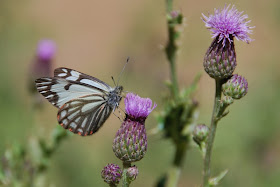Yes, it has been a while since my last post (sorry about that!)... I haven't spent a lot of time out in the woods looking for butterflies this summer, partly because I've been so busy, and partly because the weather hasn't been the most cooperative. Since most of my spare time lately has been wrapped up in working on my "Sinlahekin project", here are some Sinlahekin statistics:
Established in 1939, primarily to protect mule deer
13,814 acres
16 miles long in a north-south direction (glacier valley)
1,300 ft to 4,000 ft elevation
Wide range of habitat... birch/willow/aspen, beaver ponds, Ponderosa Pine forest, sagebrush/bitterbrush steppe, bunchgrass/fescue, serviceberry, chokecherry, oceanspray, dry meadows, moist meadows, rocky outcrops with sedum and bitterroot, and much, much more!
Bighorn sheep, mule and white-tail deer, black bear, cougar, bobcat, turkey, quail, partridge, grouse, many other birds, mammals, and reptiles.
And of course, butterflies! 87 confirmed butterfly species so far, we're still hoping to reach 90! So along those lines, here are some of my favorite photos of my favorite species, most of which are "firsts", species that we've only found one or two individuals of so far.
First, I already wrote a bit about
Thorybes pylades (Northern Cloudywing) in the last post, but I wanted to include a photo of the egg I saw being laid by a female:
The Western Branded Skipper is not exactly "special", but I really liked this shot I was able to take of one in a gravel bar next to Sinlahekin Creek...
 |
| Hesperia colorado - Western Branded Skipper |
This photo of puddling male Oregon Swallowtails was taken in 2004 at the Sinlahekin, but it's one of my favorite butterfly photos...
 |
| Papilio machaon oregonia - Oregon swallowtail |
This photo was taken at the same sand/gravel bar as the skipper picture above. The swallowtails weren't in great shape, but I thought it was neat to see three species all together...
 |
| Left to right: Pale Tiger, Western Tiger, and Anise swallowtails |
I found this larva on a Ceanothus bush, but I can't be sure if it came off the leaves or flowers, as I shook a whole branch into my net to see what larvae I could find. Therefore, I can't be sure which species it is, as one feeds on the leaves, and the other feeds on the flowers...
|
|
| Larva of either a Brown Elfin or Hedgerow Hairstreak |
I was excited to find out that a sulphur specimen I collected a few years ago is a Pink-edged Sulphur (
Colias interior), and completes a pair, since a female was collected by another person a year later...
 |
| Male (top) and female (bottom) Colias interior |
And more "first" species for the Sinlahekin... the following image is of a female Juniper/Cedar hairstreak I collected, which is also the only one of this species ever found in all of Okanogan County! I'm still trying to find more! The second is an Anna's Blue (
Plebejus anna) collected by me, and the third is a Mormon Fritillary (
Speyeria mormonia) collected by another butterfly enthusiast, both of which are the only individuals of each species found on the Sinlahekin so far. Notice the fritillary looks rather odd? The left side is aberrant, possibly caused by a malnourished larva or damaged chrysalis.
 |
| Juniper/Cedar hairstreak, Anna's blue, Mormon fritillary (aberrant form) |
I'll try not to wait so long before my next post :-) Is there anything you'd like to learn about?























































